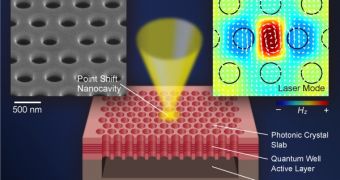A group of Japanese scientists is exploring new types of electronic nanocomponents for the computing industry, where the silicon seems to have reached the maximum limit of miniaturization. They recently built a highly efficient room-temperature nanometer-scale laser that produces stable, continuous streams of near-infrared laser light.
The best thing about it is the fact that it only uses a microwatt of power, meaning that it could soon find its way into microscopic applications, like miniaturized circuits containing optical devices. The entire device is only a few microns wide and the component that actually produces laser light has dimensions at the nanometer scale in all directions.
Toshihiko Baba, a researcher at Yokohama National University in Japan and his colleagues used a semiconductor material known as gallium indium arsenide phosphate (GaInAsP) to create the new nanolaser and the research was based on a design known as photonic-crystal laser, renowned for its small size and efficiency.
What they did was to drill a repeating pattern of holes through the laser material, the actual photonic crystal, and then they inserted an irregularity into the crystal pattern by shifting the positions of two holes by a few nanometers.
This irregularity does not allow light waves of most frequencies to form in the structure, except for a small band of frequencies that can exist in the region near the defect, thus producing a continuous output of light, rather than a series of pulses.
Another unique characteristic of this laser is the fact that it can operate at room temperature in a mode where laser light is emitted continuously, which is more difficult to achieve because it requires careful management of the device's power consumption and heat dissipation.
The researchers are the first to make such a laser which can operate continuously at room temperature, and which could have many practical applications in the continuous race for miniaturization.

 14 DAY TRIAL //
14 DAY TRIAL //